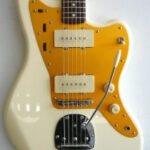The F9 Guitar Chord is a vibrant and versatile chord that adds a jazzy and funky flavour to your playing. Expanding upon the familiar dominant 7th chord, the F9 incorporates an extra note, the 9th, to create a richer, more complex sound. If you’re looking to inject some sophistication into your chord progressions, the F9 is a fantastic chord to learn.
This lesson will break down the F9 chord, exploring its construction, various shapes you can play on the guitar, and how to effectively use it in your music. You’ll find that understanding and incorporating the F9 chord will open up new sonic possibilities, particularly if you enjoy genres like jazz, funk, and blues. As a relative of the dominant 7 chord, the F9 shares a similar foundational sound but with an added layer of harmonic interest.
Unpacking the F9 Chord: Notes and Theory
So, what exactly makes up an F9 chord? At its core, the F9 chord is built from the F Major scale. It includes five distinct notes:
- F (Root – 1st degree of the F Major scale)
- A (Major Third – 3rd degree of the F Major scale)
- C (Perfect Fifth – 5th degree of the F Major scale)
- Eb (Minor Seventh – b7th degree of the F Major scale)
- G (Ninth – 9th degree of the F Major scale)
Essentially, the F9 chord is a dominant 7th chord (F7) with the 9th degree of the major scale added. The 9th degree, which is G in the case of F Major, is the same note as the 2nd degree, but we call it the 9th to indicate its function in the chord as an extension of the dominant 7th. This addition of the 9th is what gives the F9 chord its characteristic jazzy and extended sound.
Playing the F9 Chord on Guitar
The F9 is a movable chord, meaning once you learn a shape, you can shift it up and down the neck to play different 9th chords. One of the most common and foundational ways to play the F9 chord is with the root note on the 8th fret of the 5th string. This shape is often a starting point for many guitarists exploring 9th chords.
While this shape is popular, there are numerous ways to voice the F9 chord across the fretboard, each offering a slightly different sonic texture and feel. Exploring different voicings is key to truly mastering the F9 chord and utilizing it effectively in various musical contexts.
10 F9 Chord Shapes to Explore
To give you a comprehensive view of how to play the F9 chord, here are 10 different shapes. Experiment with these shapes to find your favorites and discover how each voicing sounds in different parts of the fretboard.
 Explore 10 F9 Guitar Chord Shapes: Find new ways to play the F9 chord across the fretboard
Explore 10 F9 Guitar Chord Shapes: Find new ways to play the F9 chord across the fretboard
Having multiple shapes at your disposal allows for greater flexibility in chord voicings and transitions, making your playing more dynamic and interesting.
Using the F9 Chord in Musical Contexts
The F9 chord is a highly versatile chord, finding its home in a variety of genres. It’s particularly prominent in:
- Jazz: The F9 chord is a staple in jazz harmony. Its extended sound fits perfectly within the complex and colourful chord progressions typical of jazz music.
- Funk: If you’re aiming for that classic funk guitar sound, the F9 is essential. It’s often used as a foundational chord in funky rhythm guitar parts, providing that signature groove.
- Blues: While perhaps less common than a straight dominant 7th or 7#9 chord, the F9 can add a touch of sophistication to blues progressions, particularly in more jazz-influenced blues styles.
One of the most common uses of the F9 chord is as a substitute for a dominant 7th chord. In many chord progressions, you can swap out an F7 for an F9 and achieve a similar yet richer harmonic effect.
Consider this simple chord progression in C Major:
Cmaj7 – F7 – G7 – Cmaj7
Try playing this progression and then substitute the F7 chord with an F9. You’ll notice that the progression retains its overall feel, but the F9 adds a distinct jazzy flavour. This substitution technique is a powerful tool for adding harmonic interest to your playing.
When improvising or soloing over an F9 chord, you can effectively use the F Mixolydian mode. This mode is built from the 5th degree of the Bb Major scale and naturally complements the dominant quality of the F9 chord. Experimenting with the F Mixolydian mode will help you create solos that seamlessly blend with the F9 chord’s harmonic character.
Conclusion
The F9 guitar chord is a valuable addition to any guitarist’s chord vocabulary, especially those interested in jazz, funk, and blues. By understanding its construction, exploring different shapes, and learning how to use it in progressions and solos, you can significantly enhance your playing and create more sophisticated and nuanced music. Start experimenting with the F9 chord today and unlock a world of jazzy and funky sounds!

